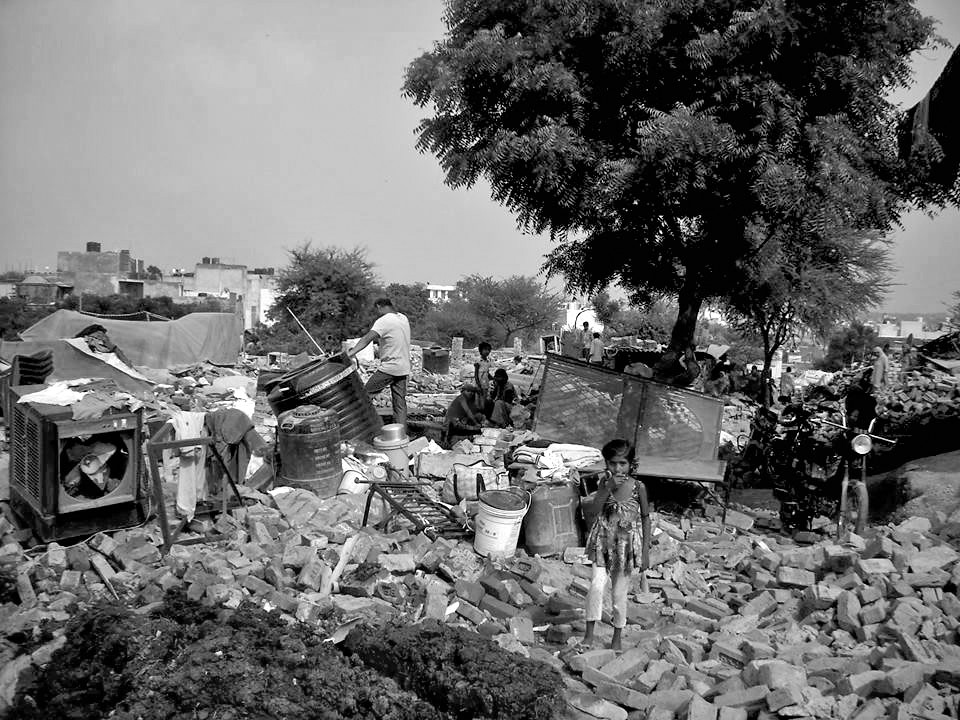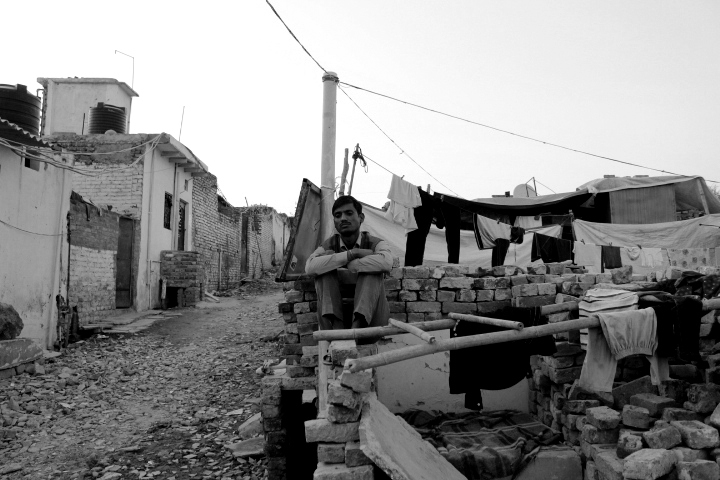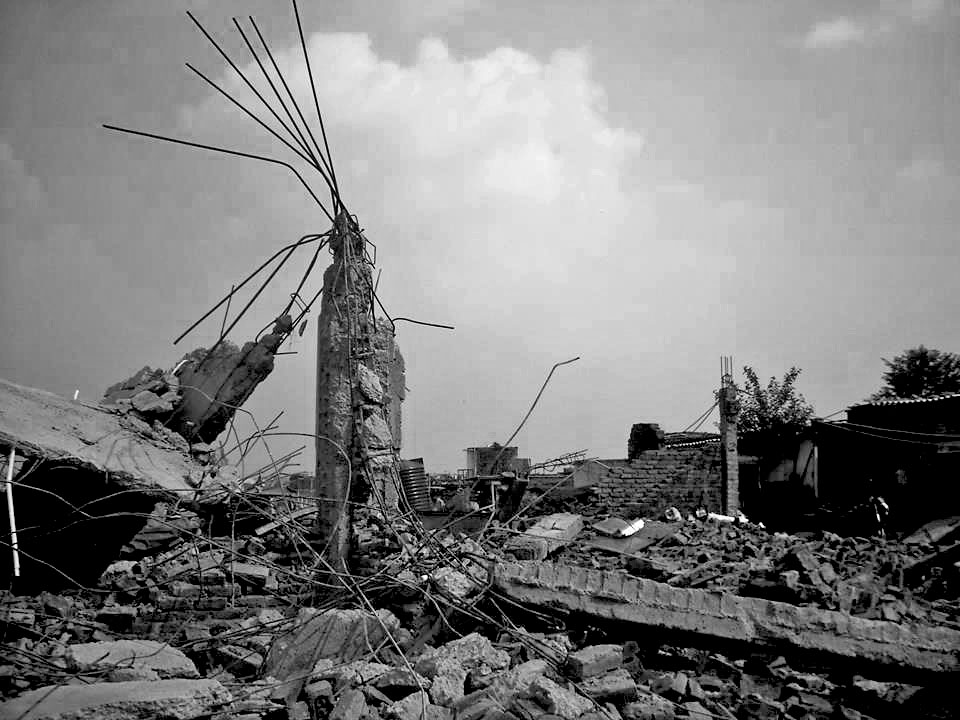by Natasha Narwal
On September 11, 2014, residents of E block, Aya Nagar, Delhi woke up to see bulldozers at their doorstep. Accompanied by the police and Central Reserve Police Force (CRPF), they came without any notice and started demolishing houses, not even giving the residents time to save their belongings.
Sanhati reports that at least two were killed: an elderly woman struck by a wall and pregnant woman who suffered shock. Besides the injuries inflicted on the body, the residents’ minds have been scarred by the site of their houses, their investments of a lifetime being reduced to a pile of rubble in a moment.
After the bulldozers had left, Deewan Singh, a daily wage worker and a resident of the colony sat outside the rubble which was once his house. Seething with rage that contorted his face, he lamented sarcastically that the promised ‘Achhe Din’ have come consisting of a steep rise in prices of basic necessities and now not even a roof on his head. Singh was referencing a popular slogan used by the BJP during the recent Lok Sabha elections.
“The whole Aya Nagar is built on illegal purchase of land, then why only our houses sore their eyes-just because we are poor?” asks Anita Devi. Devi and her husband, migrants from Chapra, Bihar, had invested their life’s savings in their house. That house now gone, she stared blankly into the uncertain future, narrating her story while cooking in the makeshift kitchen she has managed to build from the debris of her demolished house.
Aya Nagar is a village located on the southwestern edge of Delhi, on the road to Gurgaon, a satellite city home to luxury apartments and the offices of multinational corporations. In recent years, Aya Nagar has been completely transformed in character into a bustling urban settlement. This is no exception, though, as it is the story of Delhi neighbourhoods like Chattarpur and Maidangarghi as well. This expansion in Aya Nagar was the result of powerful people from the village grabbing land belonging to the local government and forest land and selling it off to various migrants to the city like Singh and Devi, desperate to get a place of their own in this hostile city.
Initially, incoming residents to Aya Nagar were primarily from marginalized sections of society, largely dispossessed landless labourers and low-income settlers from the states of Uttar Pradesh, Bihar, Rajasthan and elsewhere in India. In the last ten to fifteen years, however, the character of Aya Nagar’s population has drastically changed.
Various builders have purchased land from local real estate dealers and built huge buildings and flats to lure more upwardly mobile sections of the working population of the city. Thus, Aya Nagar has become a curious site of designer flats and sprawling markets standing amidst the very modest houses of the working class households that are being further pushed towards the margins. This is in contrast to most areas in Delhi, where there is a clear separation of middle and upper middle class localities on the one hand and working class localities on the other.
Singh came to Aya Nagar with his family in 2005 and purchased a plot of land from a local resident of the village who claimed that the land was his ancestral property and was in the name of one of his relatives. But, apparently, the land belongs to the Gram Panchayat, the local government. Despite purchasing the land and investing a lifetime in building a house over it, Singh is still an ‘illegal’ resident.
This is true for most of the residents of the area. They live on the hyphen between legality and illegality, in the ‘gray zone’ of informality neither fully integrated nor completely excluded from the city, becoming fully visible to the state only when they become an eyesore.
The establishment and growth of such ‘informal’ settlements like Aya Nagar have been an integral part of the making of urban spaces. To quote Gautam Bhan, “Like most Indian megacities, the planned city of Delhi is only a small part of the city as a whole, and historically it has always been so. The peripheral constructions and the ‘wait and watch’ game of post- facto regularization has, in fact, been the means by which much of the urban space of the city has been organized.”
Neither informal settlements nor evictions and demolitions are new to Delhi. The settlements in Aya Nagar weren’t hidden from either public view or the state. A community of nearly 5000 people with public services and an expansive built environment cannot, by any stretch of the imagination, be covert. As Ananya Roy writes:
Informality is not just that which is outside the planned/formal, as some kind of neatly bound residual order that lies beyond the state and formal planning. The informal, in fact, is “produced by the state itself”. The planning and legal apparatus of the state has the power to determine when to enact this suspension, to determine what is informal and what is not, and to determine which forms of informality will thrive and which will disappear. State power is reproduced through the capacity to construct and reconstruct categories of legitimacy and illegitimacy.
The demolition of informal homes is a regular feature of the structuring and restructuring the urban landscape of the city. According to Bhan, nearly 100,000 homes were demolished in Delhi between 1990 and 2007. More recently, a settlement in Rangpuri Pahadi, Vasant Kunj was demolished in a very similar manner to what happened in Aya Nagar, rendering hundreds of people homeless overnight.

However, as Bhan further adds, “The post-millennial evictions in Delhi and elsewhere have been different, not just in degree but in kind, from evictions in the past.” He explains:
The lack of resettlement or compensation in most cases, the use of altered definitions of “public interest”, the silence and the lack of empathy within the government, media and the public” are all markers of this difference. The difference itself is marked and framed by various transformative moments like the “liberal market reforms initiated in 1991 that have led to a profound economic and social restructuring; emergence of the notion of “world class cities” through increasing global interaction and a media explosion”; and more opportunities for upward mobility and aspirations of a highly consumerist lifestyle of and for the non-poor. The different character of the post-millennial evictions and demolitions can only be understood within these transformations and as part of them, as these are “markers of a larger critical shift in urban politics and, particularly, in how the urban poor in India are represented, governed and judged. It is this shift that explains and underlies both the increased occurrence of evictions as well as their reception.
What has changed over the decades after independence and especially in the new millennium is the conception of rights of the people—especially the poor—to these spaces and to the city itself. As Bhan informs us, in the heyday of nationalism through even the liberalizing years of the 1990’s:
the discourse on demolitions and evictions was marked by an empathy for the plight of the evictees, a desire to minimize harm caused during the process of demolitions and an acknowledgment of the planning failures of the state. For the urban poor in India, the right to the city, not the right to property or the rights attained as property owners, has been the basis of a claim to urban residency and citizenship. This right has always strongly derived from national citizenship and been legitimized by recognition of the working migrant poor – as (“humble”) workers, providers of services, (vulnerable) citizens of the state and subjects of the national development ideal. It is this recognition that has been steadily eroded in the first decade of the new millennium. The increasing frequency, ethical acceptability and apparent inevitability of evictions without resettlement in millennial Delhi mark the rupture of precisely this set of claims that defined the right of the poor to the city.
The demolitions in Aya Nagar and their aftermath are symptomatic of these changes. It has been more than four months since the demolitions took place and most residents have resigned themselves to their fate without any hope of justice. The threat of further demolitions on an ever bigger scale looms large on their heads, as every other day officials like patwaris accompanied by police come and mark more areas and houses to be cleared.
‘Why did the government gave us electricity connections, water pumps, ration cards, Aadhar cards in the first place if we are not allowed to stay here? Was the government sleeping when all these lands were being sold? Why did they not claim the land then?’ asks Santosh Devi, her husband Gyan Chand and various other residents who have been left in the lurch, huddled outside the demolished houses.
Forget answers: there is nobody available to even ask questions to. The local politicians and government officials have turned a blind eye to the plight of the people as they themselves have liaisons with the powerful lobby of the dealers and refuse to take any stand in the matter. In fact it is through these very government officials that the dealers mediate access to water, electricity and other facilities for the residents, at the same time extorting more money for these services.
At the beginning of E block stands a fancy flat and an office of the local dealer Babloo Pehalwan, from whom most of the residents purchased their land. It was not even touched by the bulldozers, as he and other dealers like him work in close liaison with official machinery of the state.
At best, politicians come with the promise of regularization of the settlements at election time, only to get a fit of amnesia and disappear later. As a result, residents have turned to protest. In an attempt to raise their voice against the injustice of losing their houses and getting their voice heard, the residents staged a dharna (sit-in protest) and blocked the road in front of the nearby Arjangarh Metro Station the day after the demolitions. It was met by a brutal lathicharge by the police on the demonstrators.
Still not relenting, protesters gathered again the next day and staged a dharna at Jantar Mantar, a popular site of protest in Delhi, and made an appeal for justice to the Central Government. But the protesters have not yet heard anything back from the government and now have lost the hope of even getting any response.
What has disheartened them more than the lack of reply from government officials is the fact that even the media has not taken any cognisance of their plight and struggle. “The  demolitions and even the Dharna got no media coverage while an incident of breaking the gate of the house of a local powerful dealer was given front page coverage in the papers. Why, because our houses are not fancy enough for the newspapers?” lamented Singh.
demolitions and even the Dharna got no media coverage while an incident of breaking the gate of the house of a local powerful dealer was given front page coverage in the papers. Why, because our houses are not fancy enough for the newspapers?” lamented Singh.
While the more upwardly mobile sections of Aya Nagar residents are looking for options to move, those having a hand-to-mouth existence stick to the rubble of bricks and stones which were once their homes. Picking up the pieces again, they have started rebuilding their houses. Having invested their life’s savings, they have nowhere to go now. They know, though, that they can now never sleep for even a night without the fear of the bulldozers coming the next morning. Meanwhile the house of the local dealer will stand tall in front of them, reminding them every day of the precariousness of their own lives.
Natasha Narwal is a student of Development Practice at Ambedkar University, Delhi and a political activist interested in issues of labor, gender, and development in South Asia. She can be reached at natasha [dot] narwal [at] gmail [dot] com.

